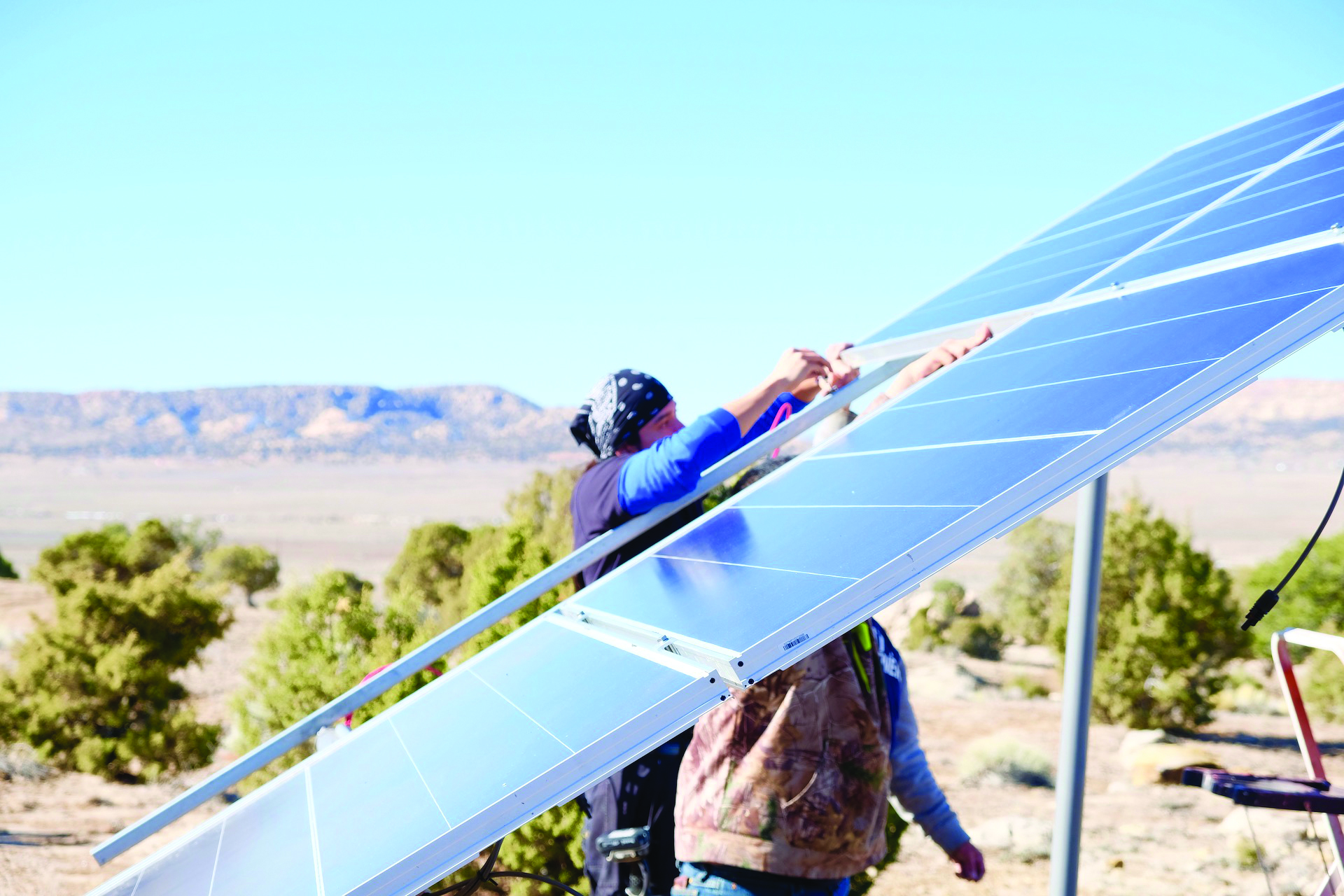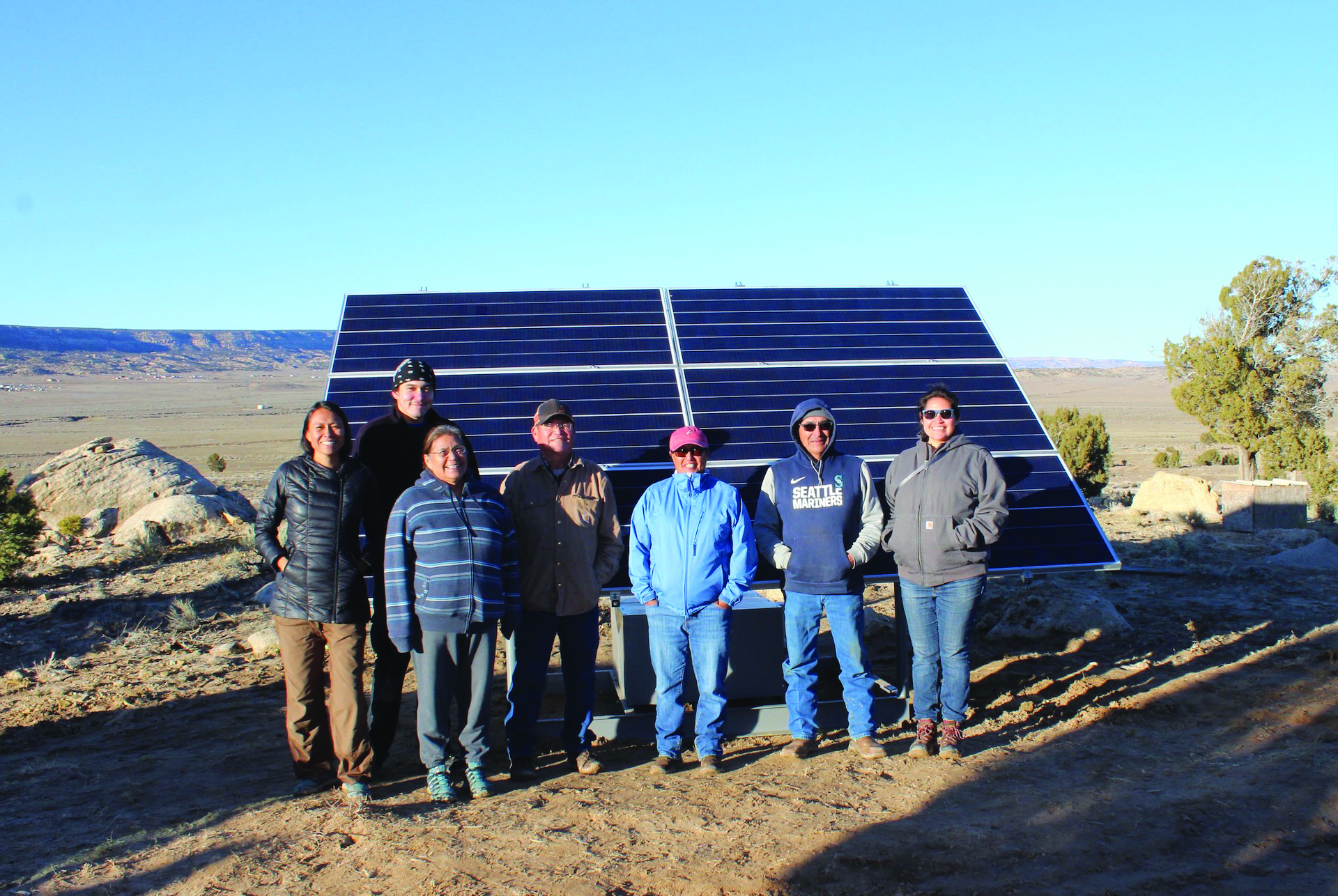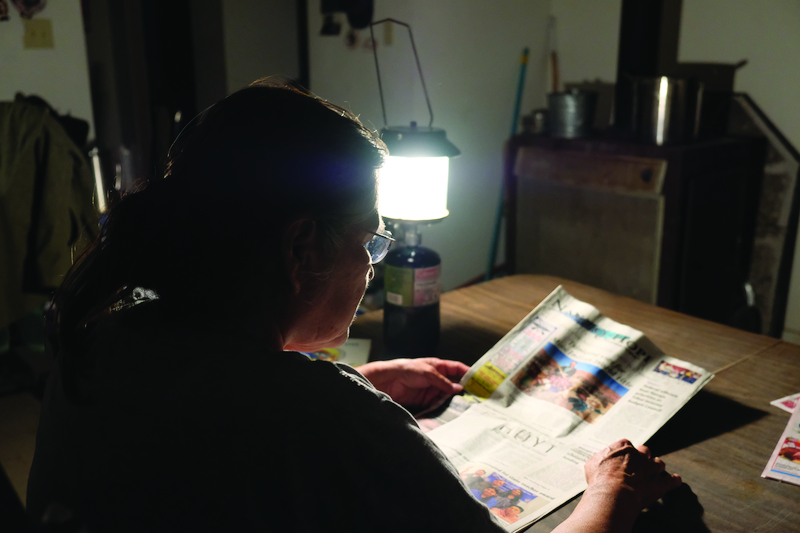Written by Wahleah Johns

Solar installer Nicholas Aberle works on the Smoke Signal off-grid photovoltaic (PV) installation. Photo: Suzanne Singer.
Access to electricity is a human right, essential to people’s health, security, and livelihoods. Of the 20,000 families in the United States without access to electricity, three-quarters live on the Navajo Nation. Despite their lands providing fossil fuels that have powered the West for 50 years, these families have been left in the dark.
Native Renewables is an Indigenous, women-led organization committed to empowering these families with affordable, reliable, and clean electricity and catalyzing a just transition for the Navajo Nation. Engineers, solar entrepreneurs, and tribal members from the Navajo and Hopi tribes make up Native Renewables, whose mission it is to empower Native American families to achieve energy independence. Our values are to provide a holistic approach to clean energy projects with four pillars: tribal sustainability, regenerative culture, engagement, and a thriving organization.
Access to electricity for Navajo families is expensive, as power-line extension is costly and no financing options exist for low-income families to pay for power. With these limiting factors in mind, Native Renewables has designed a rural electrification program called the Navajo Clean Energy Program that will offer each of the 15,000 Navajo households access to a lease and an off-grid photovoltaic (PV) system + storage to power lights, a refrigerator, cell phones, and appliances. This program has a workforce development component to train Native American solar installers to build and maintain off-grid PV systems and generate solar jobs.
Tribes and Indigenous Peoples disproportionately represent both dirty energy and clean energy resources, where 80 percent of fossil fuels and 80 percent of the world’s biodiversity are on and near Indigenous Peoples’ lands. Indigenous Peoples’ land base and ecological traditional knowledge can provide guidance and alliance toward solutions to heal the planet and communities.
The Navajo Nation is the largest Native American tribe in the US, with a landmass the size of West Virginia occupying northeastern Arizona, northwestern New Mexico, and southern Utah. The majority of Navajo families live in rural locations, comanaging miles of lands from previous generations. These families are pastoralists, farmers, ranchers, herbalists, healers, artisans, teachers, coal miners, coal plant workers, mechanics, builders, tribal employees, and entrepreneurs, all working with the terrains constrained by Wi-Fi/cell service, unpaved roads, no running water, and extreme weather conditions. The Navajo have an unemployment rate of 48.5 percent and average per capita income of $10,695, demonstrating the need for low-cost energy solutions.

The Native Renewables team (left to right): Wahleah Johns, Nicholas Aberle, Ella Lee, Gary Singer, Deb Tewa, Pete Dohi, and Suzanne Singer. Photo: Suzanne Singer.

Ella Lee, member of the Native Renewables team, reading by the light of a kerosene lamp. Photo: Suzanne Singer.
Native Renewables’ energy access strategy comes from 18 months of researching Navajo families’ fuel costs and the barriers to accessing electricity. We have engaged our tribal utility and US and international off-grid solar providers to help understand the market that matches customers with affordability, system size, and commitment.
In order to scale off-grid PV knowledge and installation, we’ve designed a solar workforce program that includes both in-classroom and hands-on learning. In October 2019, Native Renewables offered our first eight-week solar workforce training to teach trainees how to design, build, and maintain off-grid PV systems. We held the training on the Navajo Nation to create educational access for rural Navajo and Hopi applicants. Training includes the fundamentals of energy and PV systems; safety; electricity and wiring taught by a certified electrician; balance of system components; battery storage; design of systems; and site evaluation. The soft skills that are incorporated are customer service (Interface and education), marketing for services, and project reporting. In November 2019 we graduated all ten trainees of the solar workforce program, exceeding all of our expectations and preparing these ten off-grid solar installers for work.
The first phase of the Navajo Clean Energy Program is to deploy up to 100 off-grid PV systems as a demonstration project to refine products, financing, key partnerships, installation, and service within one year. We will collect data and use the lessons learned to refine the economics and mechanisms to scale toward the remaining 14,900 homes on Navajo land.
The Navajo Nation has some of the best solar resources in the world and seeks investment to spark a restorative economy that fits the needs of the people. With solar prices dropping and the coal industry becoming less economical, Native Renewables sees this as an opportune time to create a solar workforce and energy access program to tackle the growing unemployment rates and offer job training skills closer to home.
We see systemic change occurring at each home that uses off-grid solar—where the most underserved demographic in the US will become natural leaders of sustainable living by managing and owning their power with the sun and modeling Indigenous self-reliance and self-determination.
Wahleah Johns is a member of the Navajo (Dine) tribe and comes from the community of Forest Lake, Arizona, atop Black Mesa. She is cofounder and executive director of Native Renewables. Her work with the Black Mesa Water Coalition and Navajo Green Economy Coalition has led to groundbreaking legislative victories for groundwater protection, green jobs, and environmental justice. As of 2021, Johns serves as Senior Advisor for the U.S. Department of Energy (DOE) Office of Indian Energy Policy and Programs.
This post is an excerpt from an article originally published in the Summer 2020 issue of Design Journal, Cooper Hewitt’s biannual magazine.